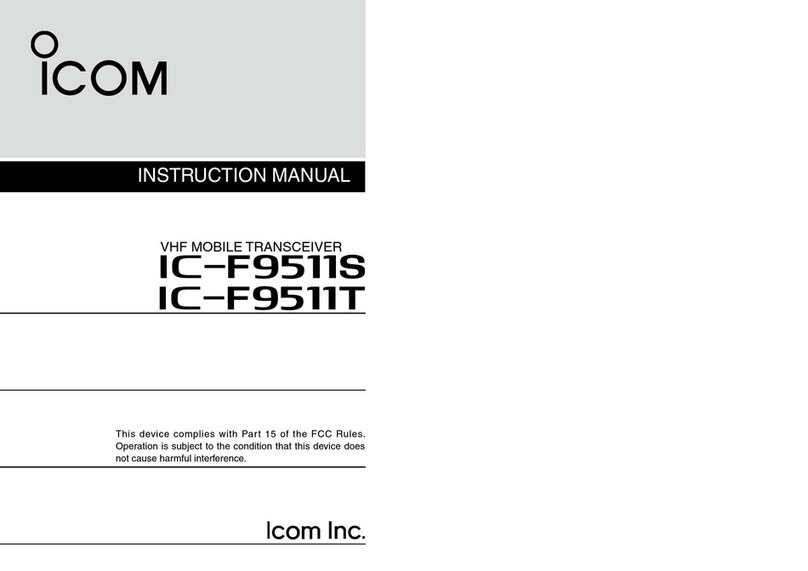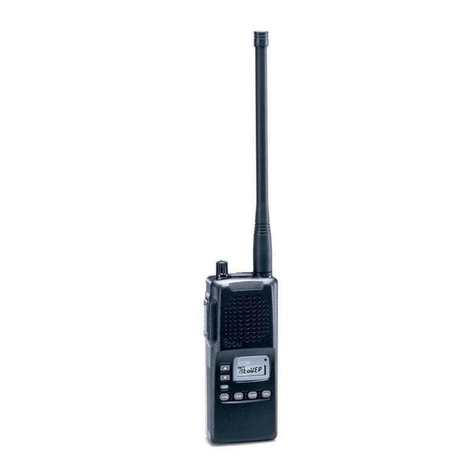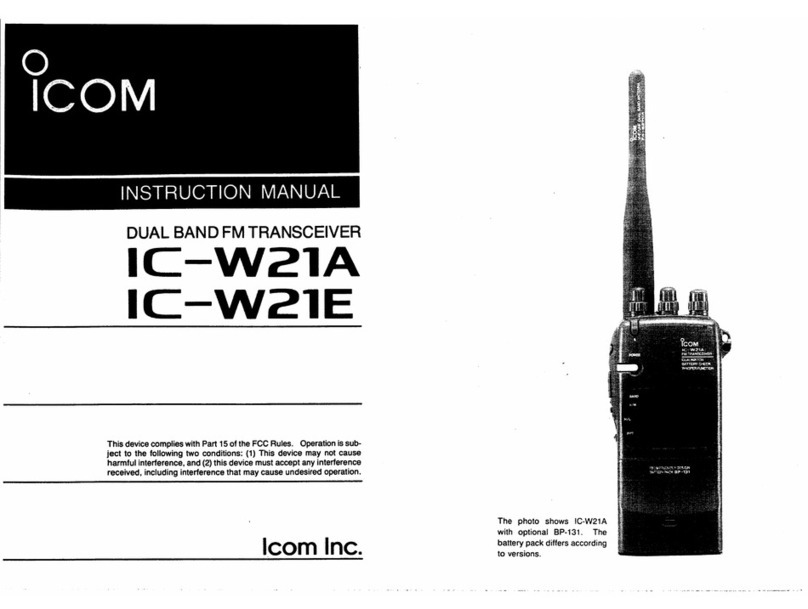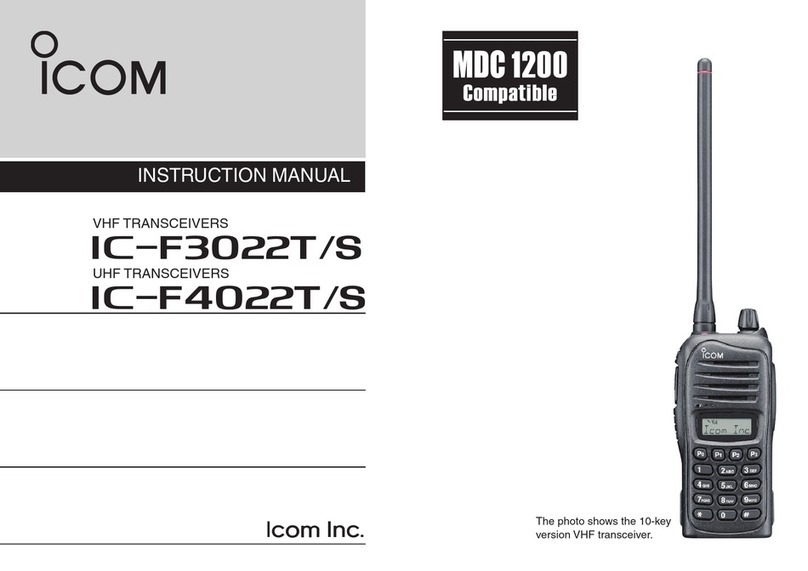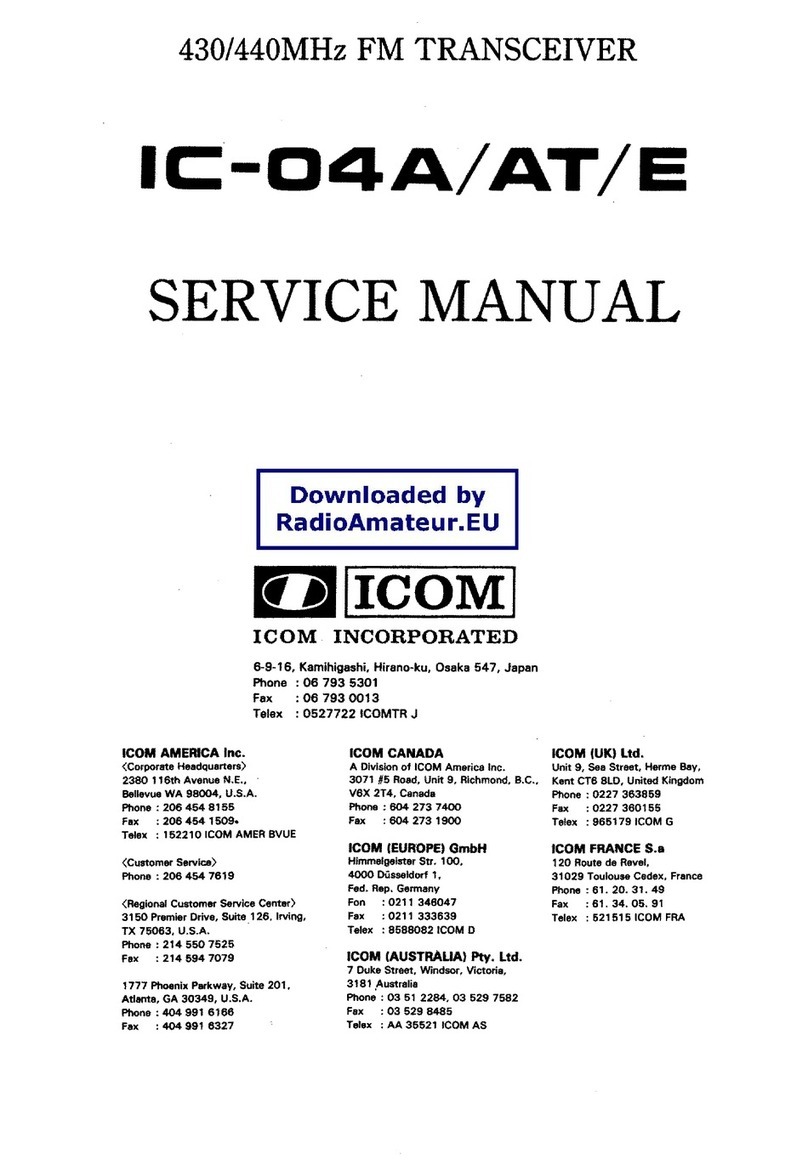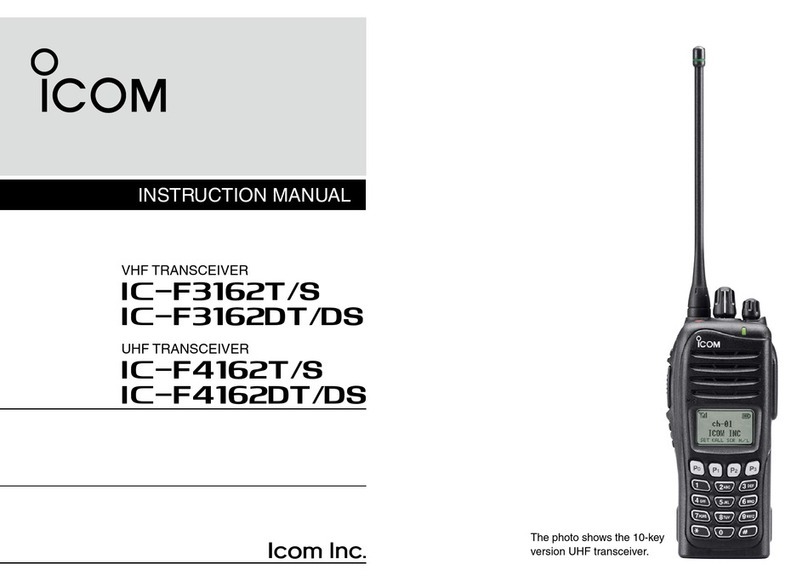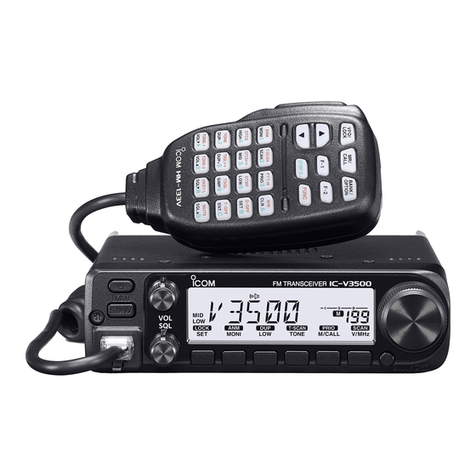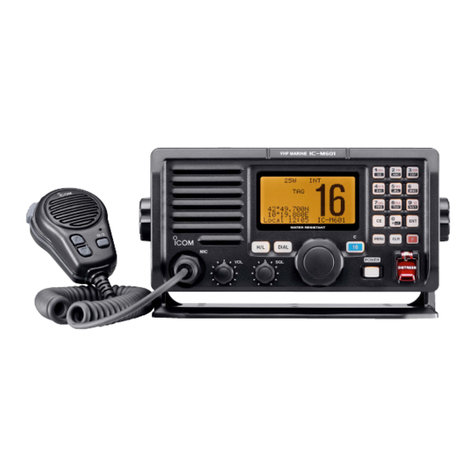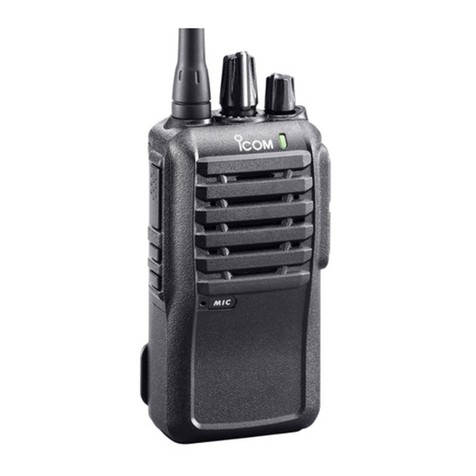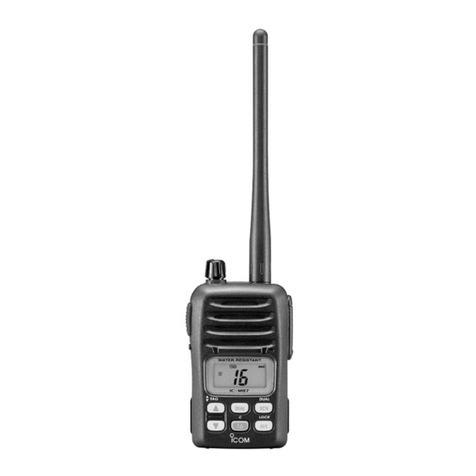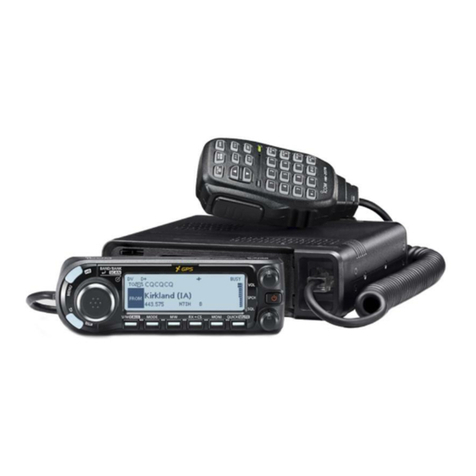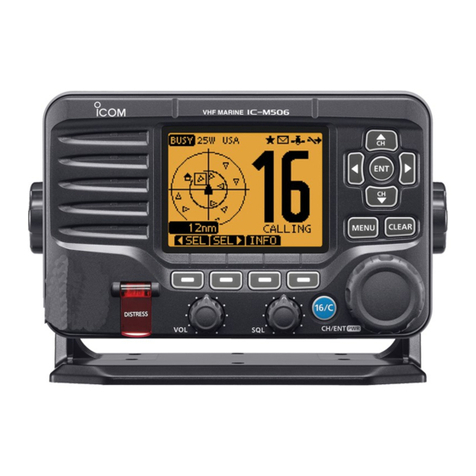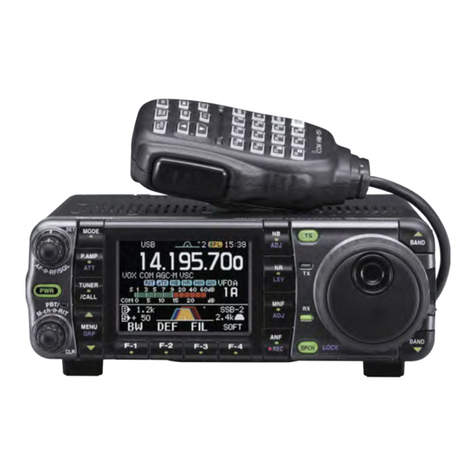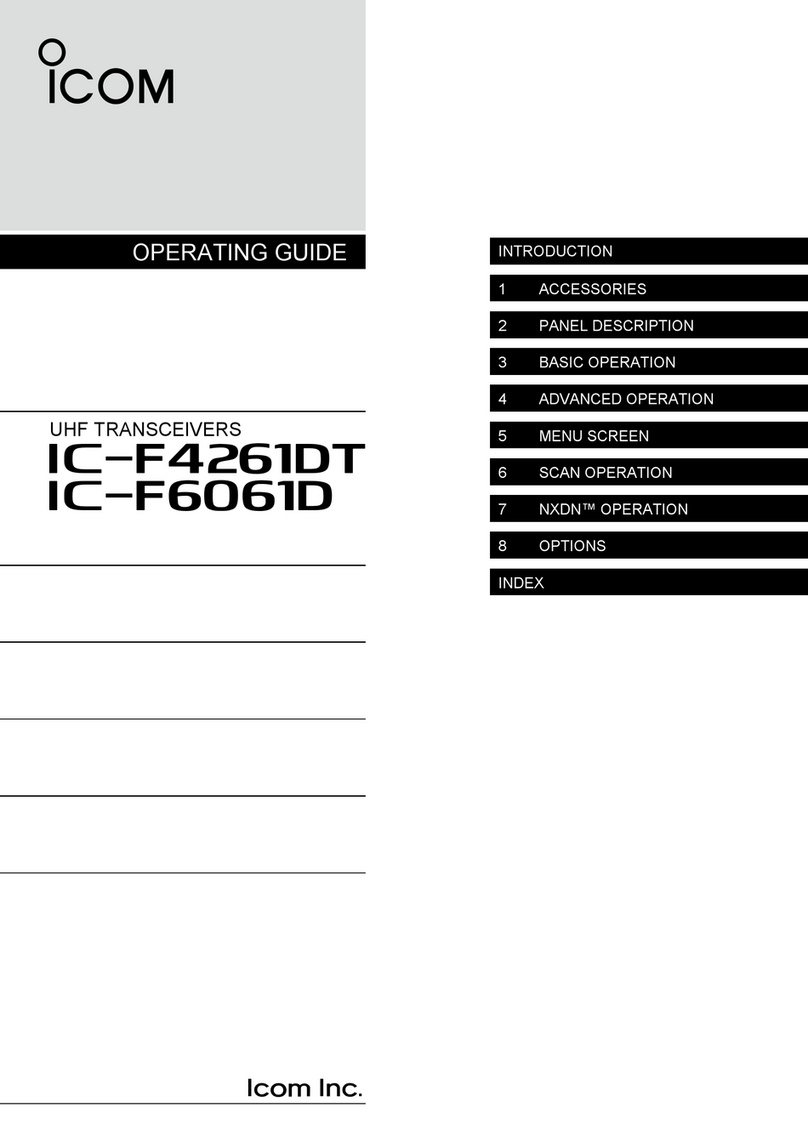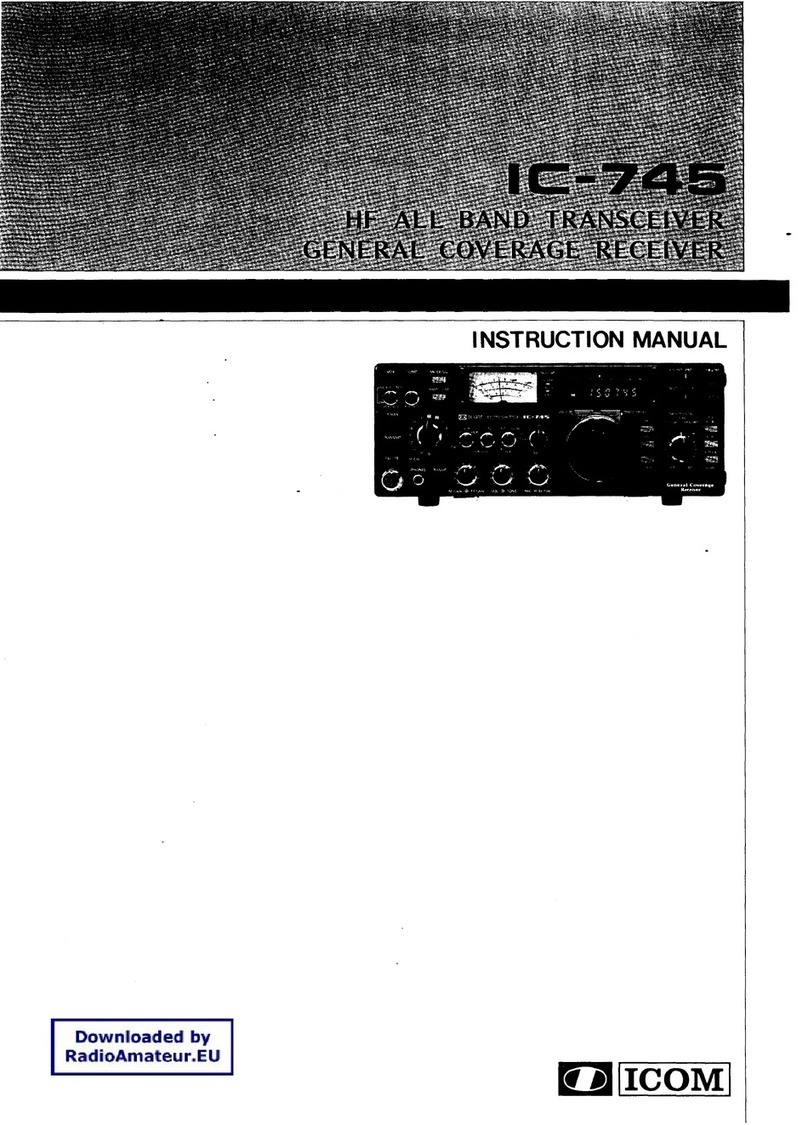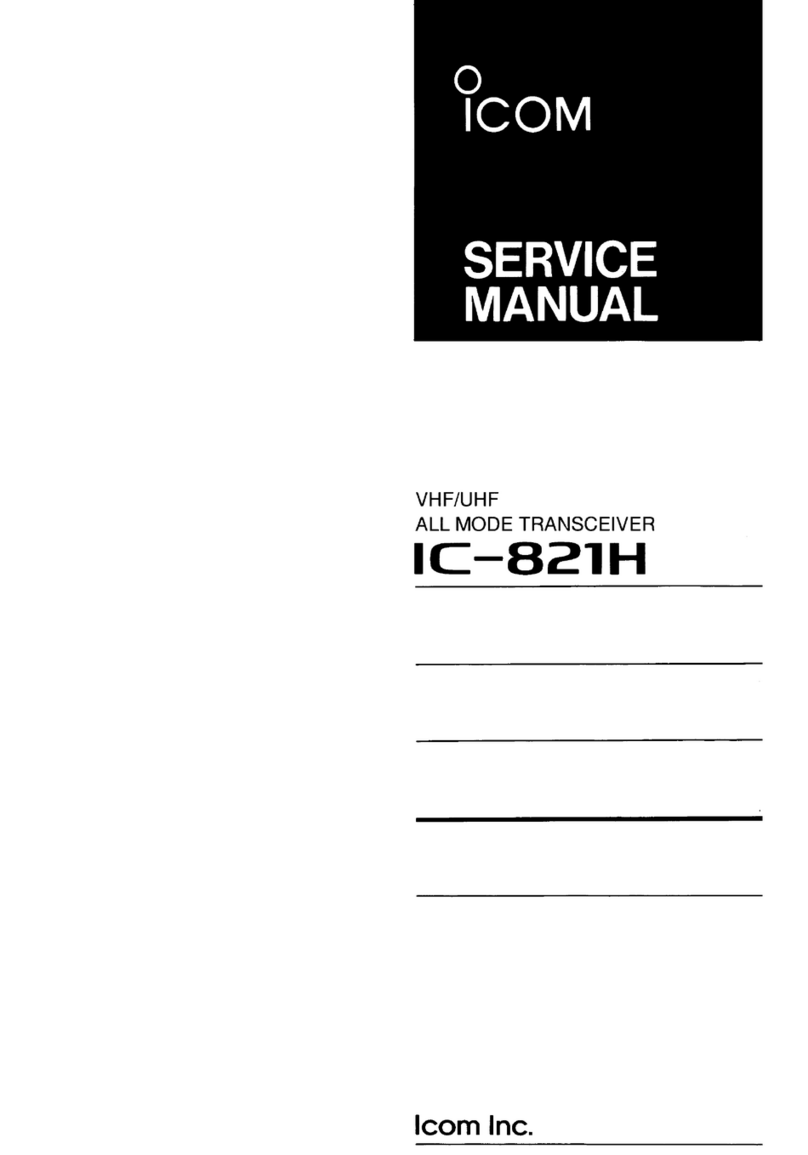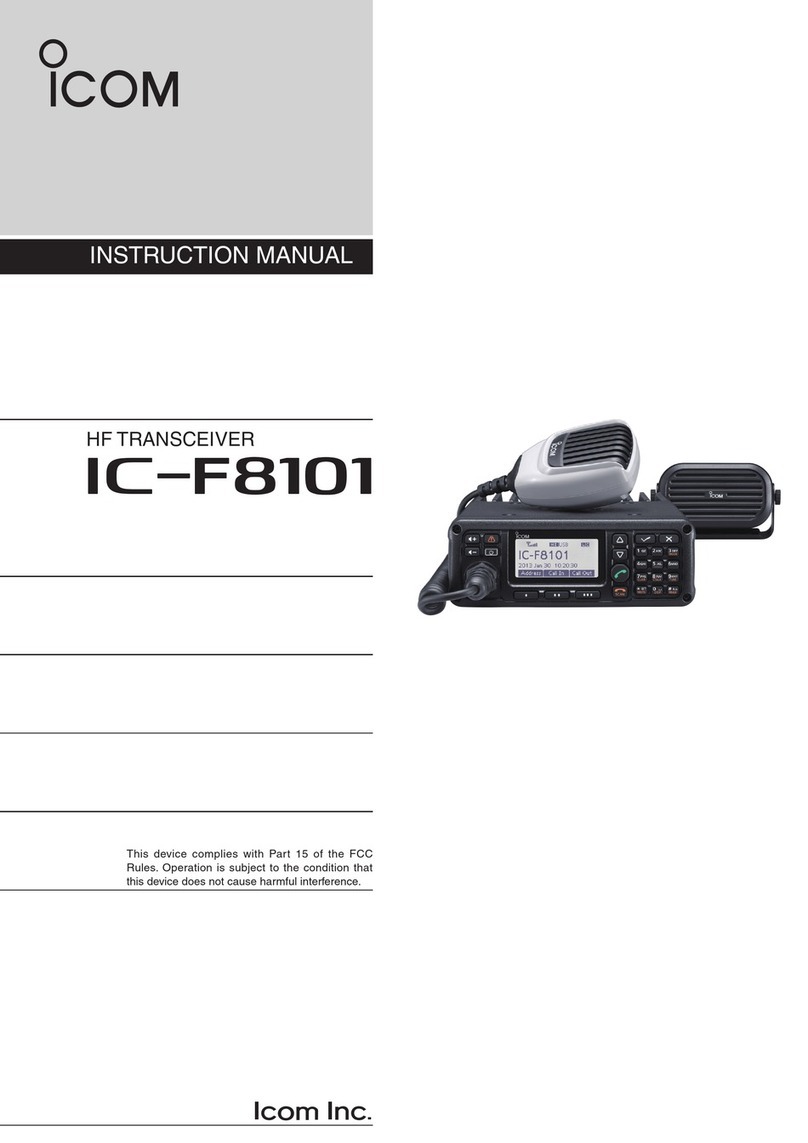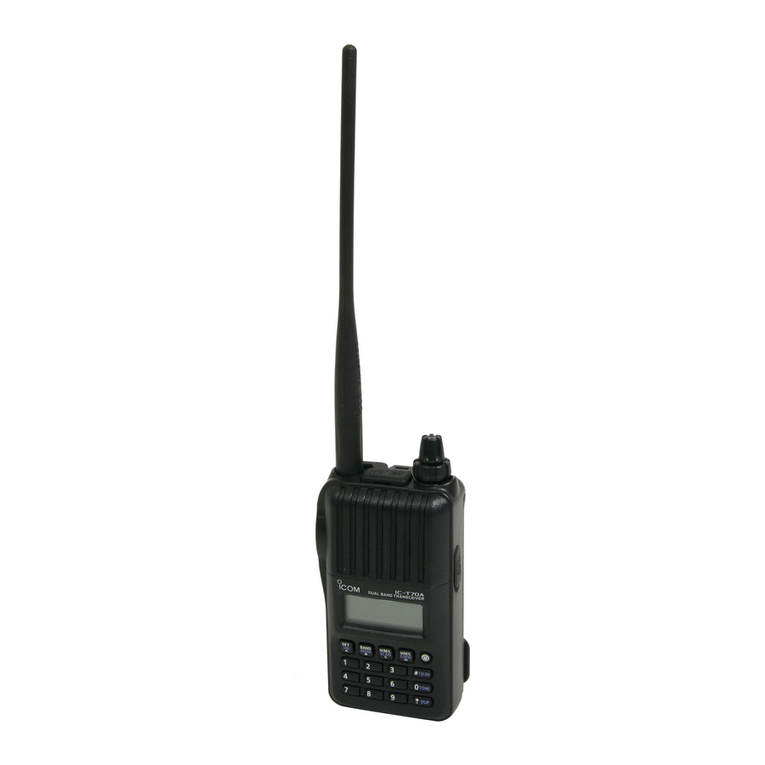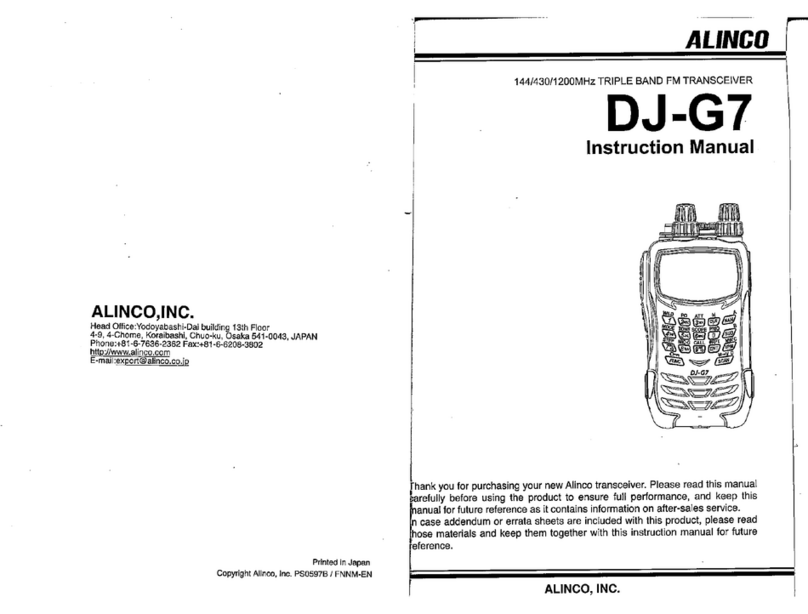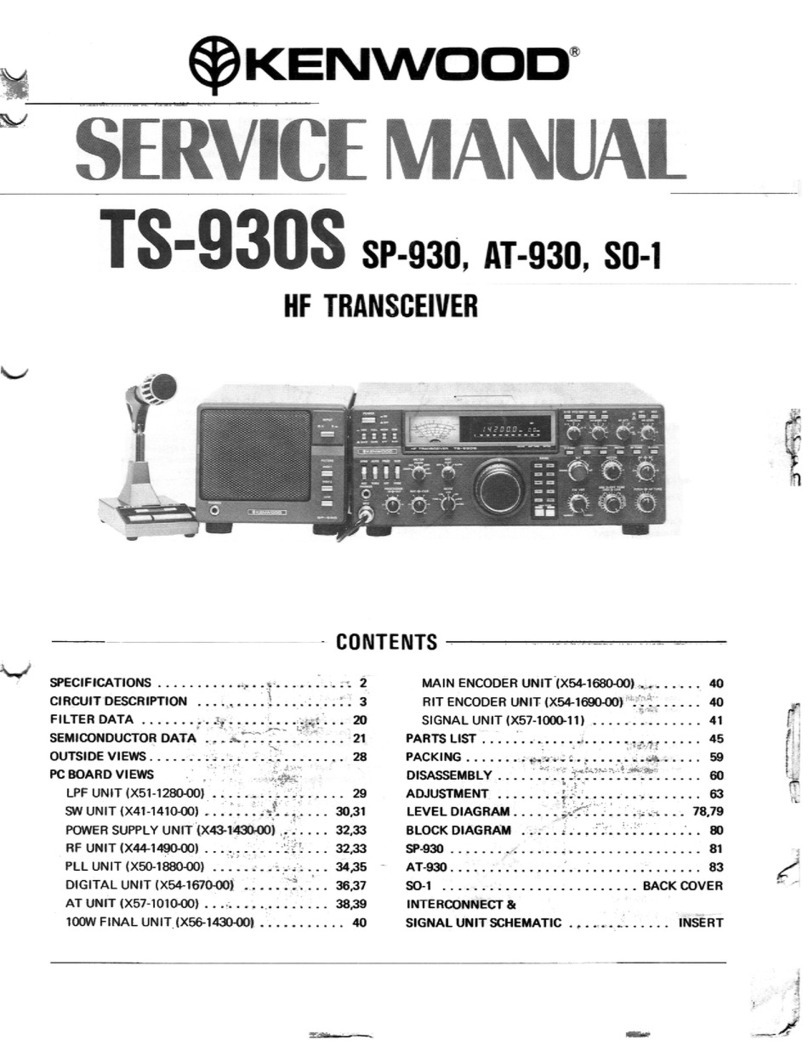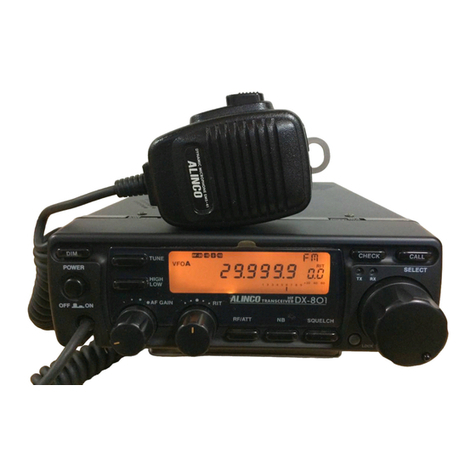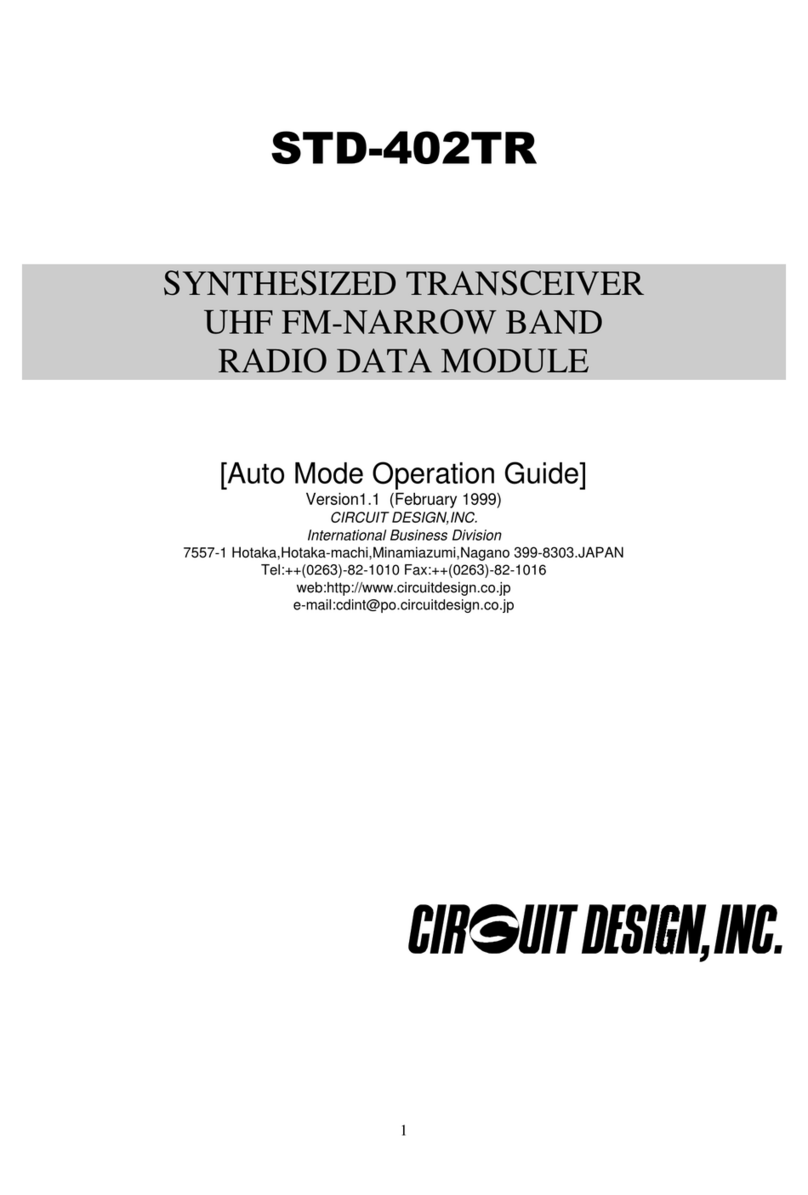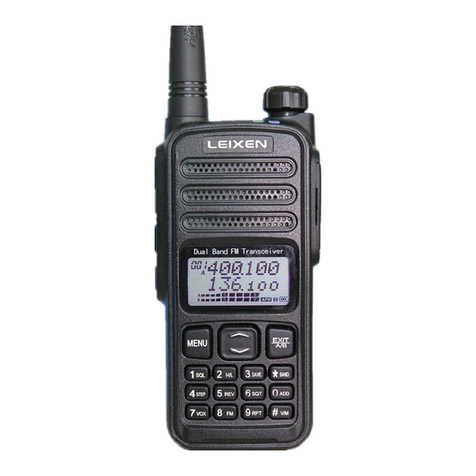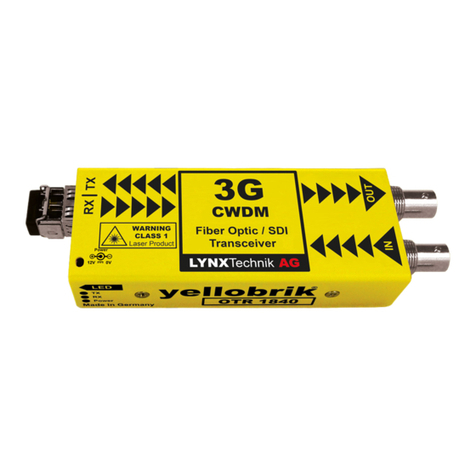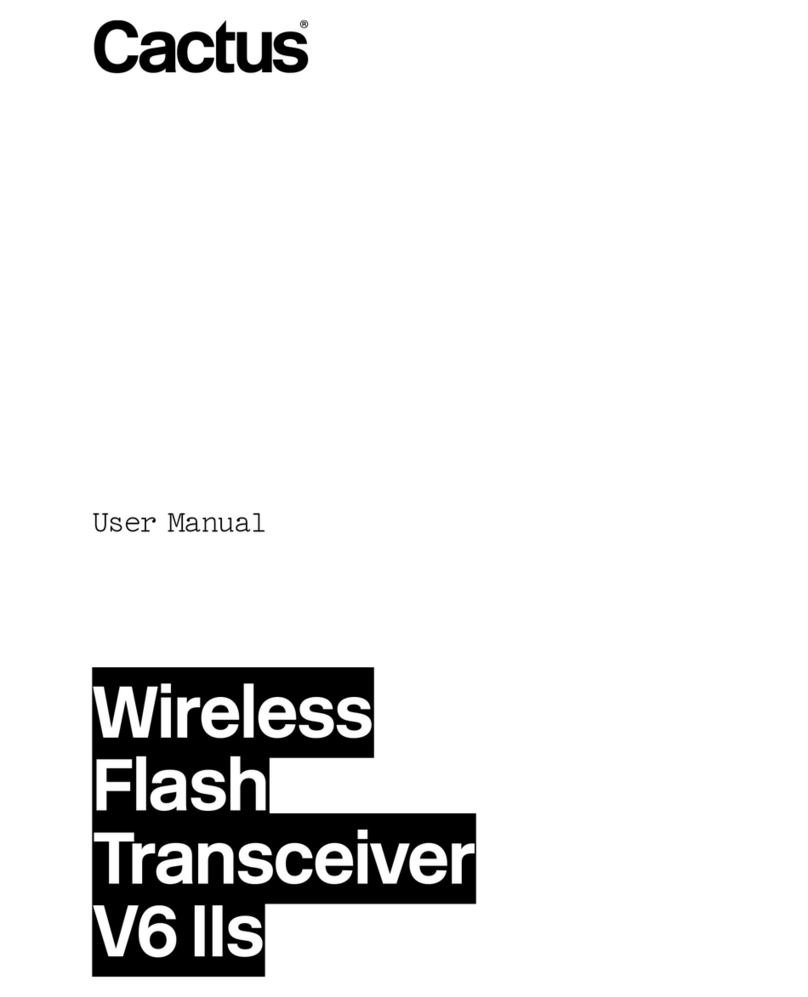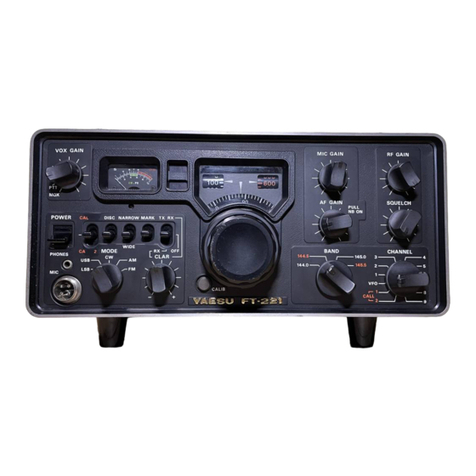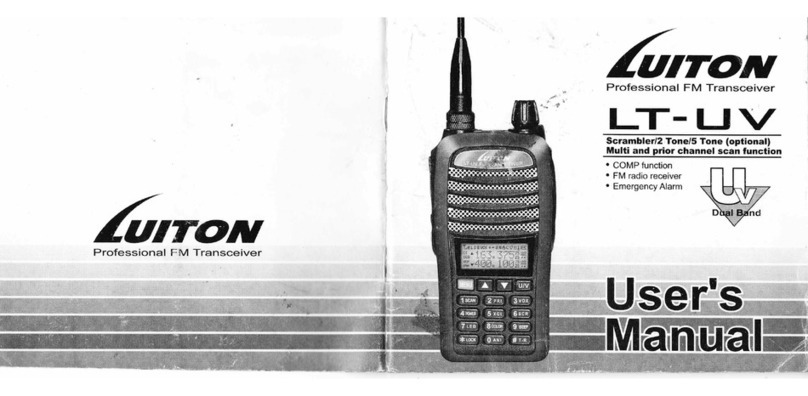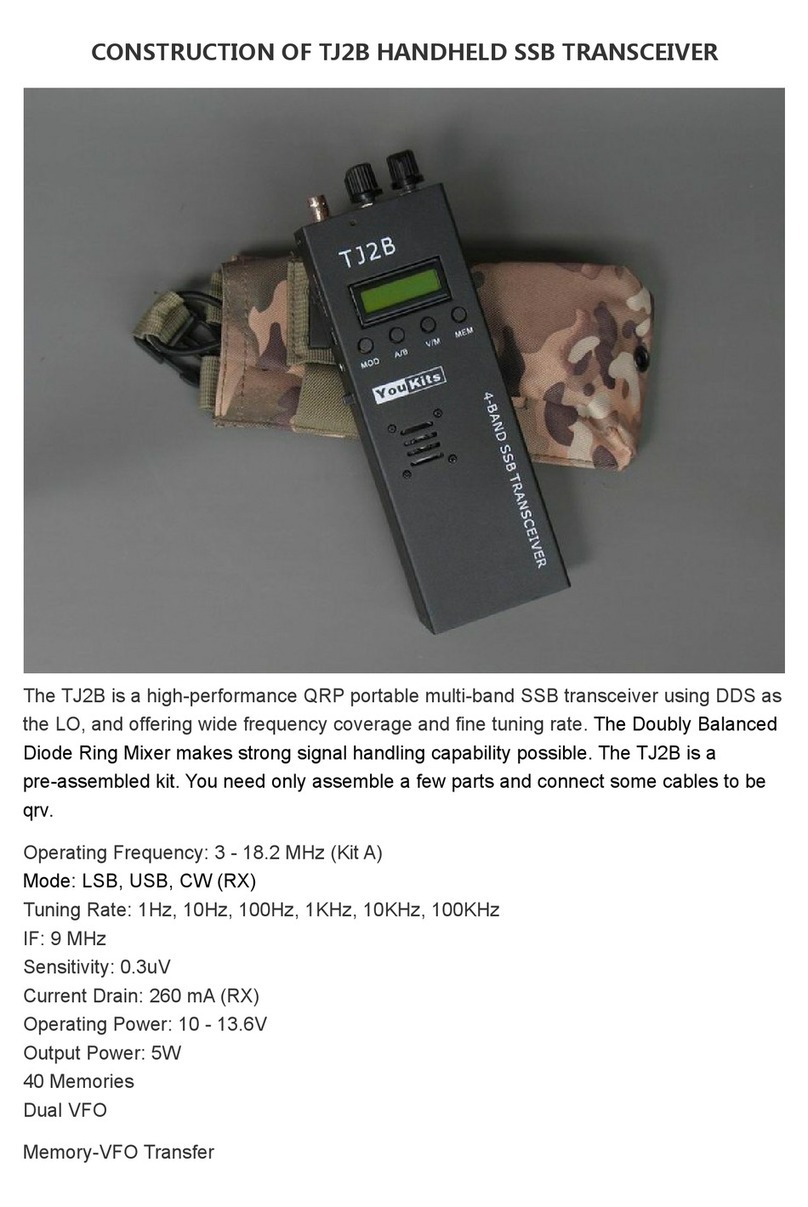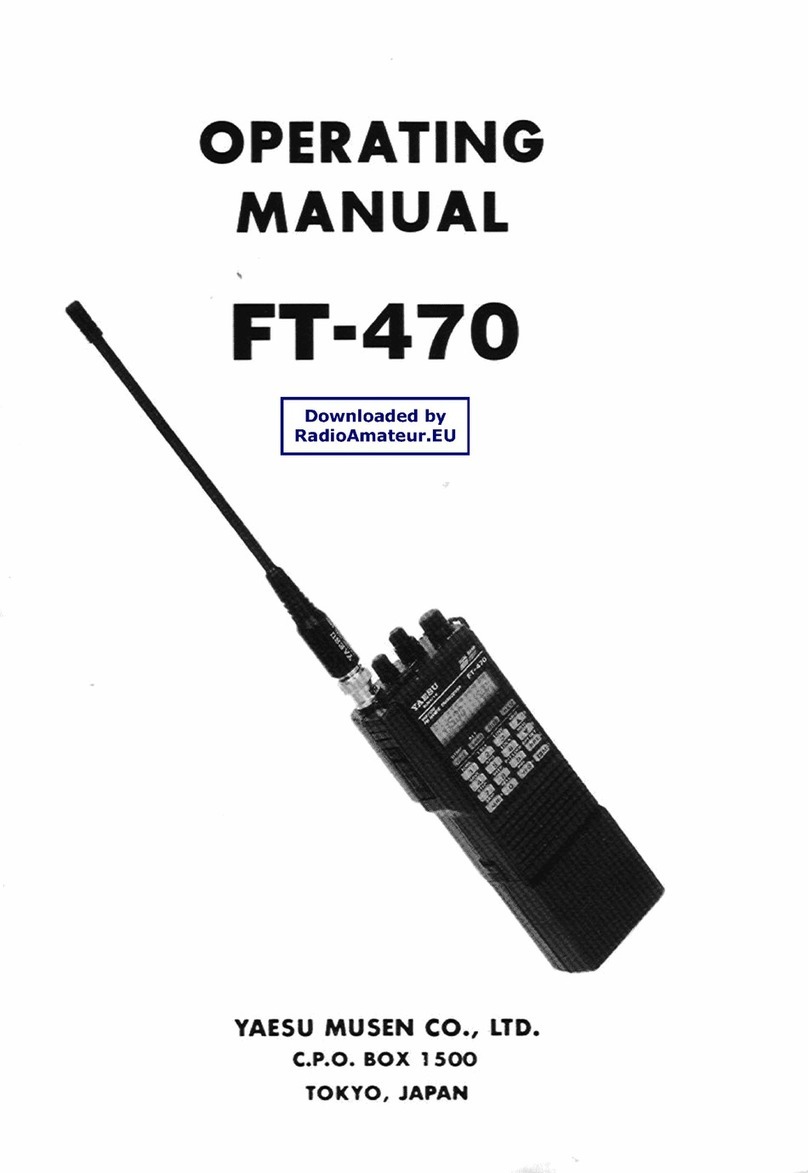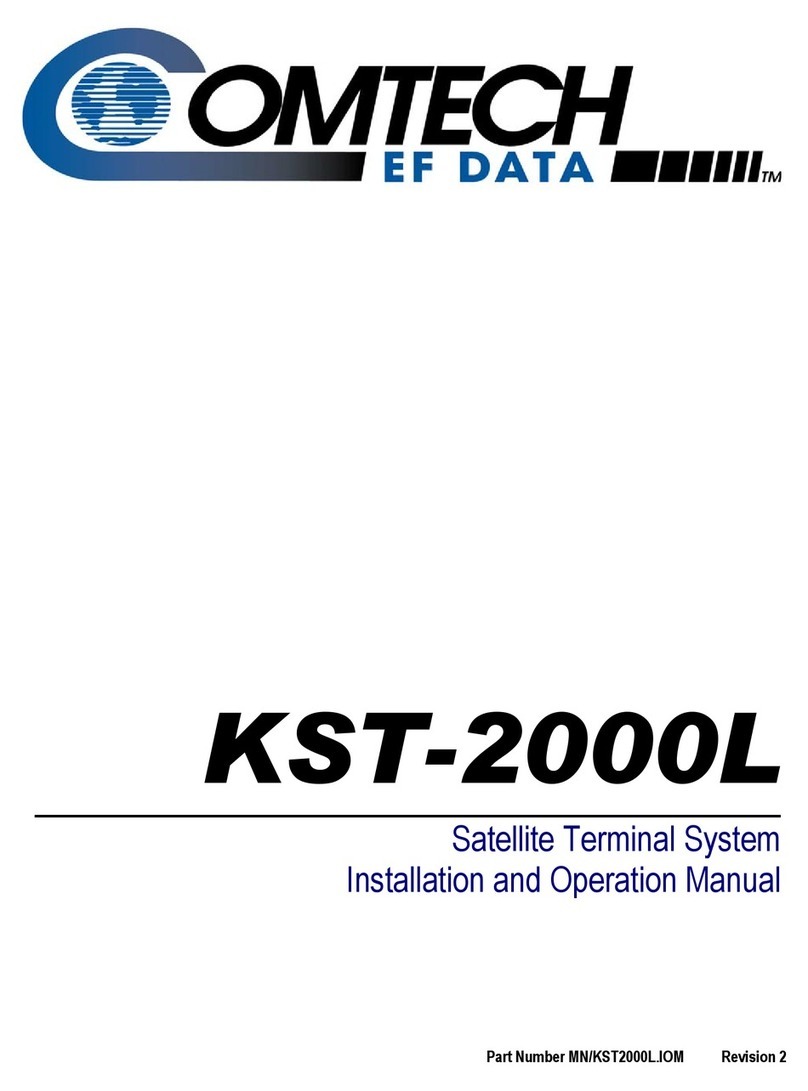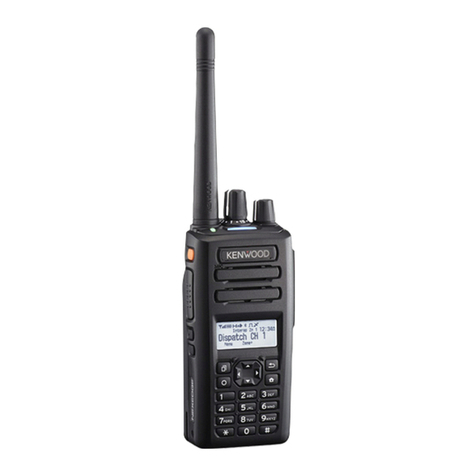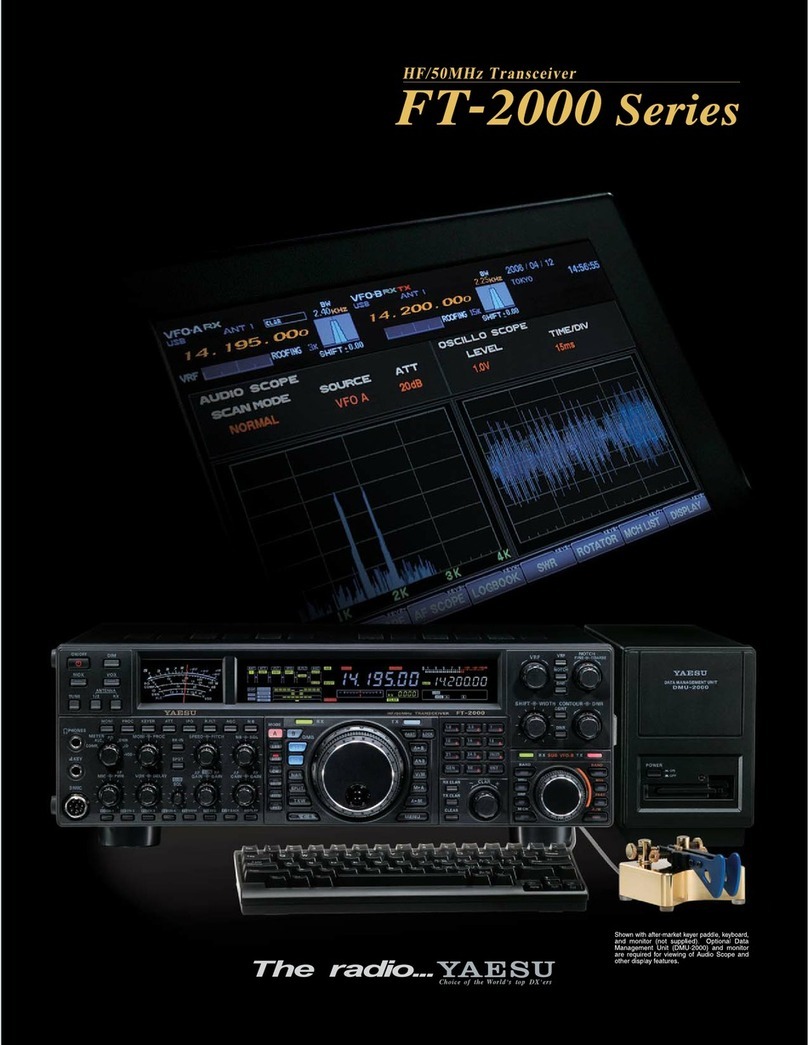Icom IC-A24E User manual

INSTRUCTION MANUAL
iA6E
iA24E
VHF AIR BAND TRANSCEIVER
IC-A24E IC-A6E

i
FOREWORD
Thank you for purchasing this Icom product. The IC-A24E/
A6E VHF AIR BAND TRANSCEIVER is designed and built
with Icom’s state of the art technology and craftsmanship.
With proper care this product should provide you with years
of trouble-free operation.
IMPORTANT
READ ALL INSTRUCTIONS carefully and completely
before using the transceiver.
SAVE THIS INSTRUCTION MANUAL—This in-
struction manual contains important operating instructions
for the IC-A24E/A6E.
EXPLICIT DEFINITIONS
SUPPLIED ACCESSORIES
Accessories included with the transceiver: Qty.
q Antenna .......................................................................... 1
w Belt clip .......................................................................... 1
e Handstrap ...................................................................... 1
r Battery pack* or battery case.......................................... 1
t Wall charger* .................................................................. 1
yCarrying case* ............................................................... 1
uHeadset adapter* ........................................................... 1
*Not supplied, or the shape may be different, depending on the
version.
qw e
t
r
y
u
WORD DEFINITION
RWARNING!
CAUTION
NOTE
Personal injury, fire hazard or electric shock
may occur.
RDANGER! Personal death, serious injury or an explo-
sion may occur.
If disregarded, inconvenience only. No risk
of personal injury, fire or electric shock.
Equipment damage may occur.

ii
TABLE OF CONTENTS 1
2
3
4
5
6
7
8
9
10
11
12
13
FOREWORD ..................................................................................... i
IMPORTANT...................................................................................... i
EXPLICIT DEFINITIONS................................................................... i
SUPPLIED ACCESSORIES.............................................................. i
TABLE OF CONTENTS.................................................................... ii
PRECAUTION ................................................................................. iii
1 ACCESSORY ATTACHMENT ....................................................1
2 PANEL DESCRIPTION ..........................................................2–7
Panel description
■....................................................................2
Function display
■.....................................................................6
3 BASIC OPERATION.............................................................8–11
Setting a frequency
■.................................................................8
Setting a squelch level
■............................................................8
Channel spacing setting
■..........................................................8
Receiving
■................................................................................9
ANL function
■...........................................................................9
Transmitting
■.............................................................................9
Low battery indicator
■.............................................................10
Recall function
■......................................................................10
Accessing the 121.5 MHz emergency frequency
■..................11
Setting beep tone
■..................................................................11
Side tone function
■.................................................................11
Lock function
■.........................................................................11
4 MEMORY OPERATION......................................................12–15
Memory channel selection
■....................................................12
Transferring memory contents
■..............................................12
Programming a memory channel
■..........................................13
Memory names
■.....................................................................14
Clearing the memory contents
■..............................................14
5 SCAN OPERATION............................................................16–17
Scan types
■............................................................................16
COM band scan
■....................................................................16
Memory scan
■........................................................................16
“TAG” channel setting
■............................................................17
6 VOR NAVIGATION (IC-A24E ONLY) .................................18–24
VOR indicators
■......................................................................18
VOR functions
■.......................................................................19
Flying to a VOR station
■.........................................................20
Entering a desired course
■.....................................................22
Crosschecking position
■.........................................................22
Duplex operation
■...................................................................24
7 CLONING .................................................................................25
8 BATTERY PACKS ..............................................................26–29
Battery cautions
■....................................................................26
Battery charging
■....................................................................26
Optional battery case
■............................................................27
Optional battery chargers
■.....................................................28
9 SPECIFICATIONS ..............................................................30–31
10 OPTIONS..................................................................................32
11 OPTIONAL HEADSET CONNECTION....................................33
12 TROUBLESHOOTING .............................................................34
13 COUNTRY CODE LIST ...........................................................35

iii
RDANGER! NEVER short the terminals of the battery
pack. Also, current may flow into nearby metal objects, such
as a necklace, etc. Therefore, be careful when carrying with,
or placing near metal objects, carrying in handbags, etc.
RDANGER! Use and charge only specified Icom battery
packs with Icom radios or Icom chargers. Only Icom battery
packs are tested and approved for use with Icom radios or
charged with Icom chargers. Using third-party or counterfeit
battery packs or chargers may cause smoke, fire, or cause
the battery to burst.
RWARNING! NEVER hold the transceiver so that the
antenna is very close to, or touching exposed parts of the
body, especially the face or eyes, while transmitting. The
transceiver will perform best if the microphone is 5 to 10 cm
away from the lips and the transceiver is vertical.
RWARNING! NEVER operate the transceiver with a
headset or other audio accessories at high volume levels.
Hearing experts advise against continuous high volume op-
eration. If you experience a ringing in your ears, reduce the
volume level or discontinue use.
CAUTION: NEVER connect the transceiver to an AC
outlet or to a power source of more than 11.5 V DC. Such a
connection will damage the transceiver.
CAUTION: NEVER connect the transceiver to a power
source that is DC fused at more than 5 A. Accidental reverse
connection will be protected by this fuse, higher fuse values
will not give any protection against such accidents and the
transceiver will be ruined.
DO NOT allow children to play with any radio equipment
containing a transmitter.
DO NOT operate the transceiver near unshielded electri-
cal blasting caps or in an explosive atmosphere.
DO NOT use or place the transceiver in direct sunlight or
in areas with temperatures below –20°C or above +55°C.
CLEAN and wipe dry the battery terminals after using the
transceiver in wet conditions. The terminals may rust if not
dried.
Even when the transceiver power is OFF, a slight current still
flows in the circuits. Remove the battery pack or case from
the transceiver when not using it for a long time. Otherwise,
the battery pack or installed Alkaline cell batteries will be-
come exhausted.
IMPORTANT!: IC-A24E/A6E is for GROUND STATION
USE ONLY. The IC-A24E/A6E CAN NOT and SHOULD
NOT be used in an aircraft or as the MAIN RADIO.
Icom, Icom Inc. and the Icom logo are registered trademarks of Icom Incor-
porated (Japan) in Japan, the United States, the United Kingdom, Germany,
France, Spain, Russia and/or other countries.
PRECAUTION

1
1
ACCESSORY ATTACHMENT
1
Antennaï
CAUTION: DO NOT transmit without an antenna. Other-
wise the transceiver may be damaged.
Insert the supplied antenna into the antenna connector and
screw down the antenna as shown below.
Belt clipï
Conveniently attaches to your belt.
Attach the belt clip with the supplied screws as below.
NOTE: Use the supplied screws only.
Battery pack replacementï
Before replacing the battery pack, push [PWR] for 2 seconds
to turn the power OFF.
Slide the battery release button forward, then pull the battery
pack upward with the transceiver facing away from you.
Supplied screws
NOTE: About water resistant construction
The water resistant construction provides reliable opera-
tion in wet conditions.
• Equivalent to IPX4 of corresponding international stand-
ard IEC 60529 (2001).

2
2PANEL DESCRIPTION
Panel description
■
ert
u
y
i
o
Microphone
Speaker
!6
!5
!7
q
w
!1
!0
!2
!3
!4
IC-A24E
!7
!7
IC-A6E

3
2
PANEL DESCRIPTION
qBACKLIGHT SWITCH [LIGHT]
Turns the backlight for display and keypad ON or OFF.
wPTT SWITCH [PTT] (p. 9)
Hold down to transmit; release to receive.
• “ ” appears on the function display while transmitting.
eVOLUME [VOL] (p. 9)
Adjusts the audio level.
rTUNING DIAL [DIAL] (pp. 8, 9, 11, 12)
➥Rotate [DIAL] to select the desired frequency, BANK
number and memory channel.
➥Rotate [DIAL] to set the squelch level and beep tone
level.
tANTENNA CONNECTOR [ANT] (p. 1)
Connect the supplied antenna here.
yRECALL CHANNEL UP/DOWN KEYS [Ω]/[≈] (p. 10)
➥Push to enter the recall function mode.
➥Push to call the stored frequency in the recall
mode.
➥Push , then push [Ω]/[≈]to replace stored
recall frequencies to back or front.
uSQUELCH KEY [SQL] (p. 8)
➥Push [SQL], then rotate [DIAL] to select the
squelch level.
• 24 squelch levels and squelch open (0) are available.
iPOWER SWITCH [PWR] (pp. 9, 25)
➥Hold down for 2 seconds to turn the power ON
or OFF.
➥ While holding down [MR•MW], push [PWR] to
enter the cloning function mode.
oEXTERNAL SPEAKER AND MICROPHONE JACKS
[MIC/SP] (p. 33)
If desired, connect an OPC-499 HEADSET ADAPTER and
headset.
!0 FUNCTION KEY [ ]
Push to call up the function indicator, “ ”, then
push another key to access its secondary func-
tion.
• “ ” appears for 3 seconds after is pushed; at this
time pushing again cancels the indication.
NOTE: In general, “ ” disappears when an-
other key is pushed to activate a secondary
function. However, some keys which have more
than one secondary function, (such as [DUP]),
do not cancel “ ”. In this case, “ ” automati-
cally disappears after 3 seconds.
2

4
2PANEL DESCRIPTION
!1 CLEAR KEY [CLR•DEL] (pp. 8, 10–17)
➥Push to return to the frequency mode, when
memory channel, 121.5 MHz, squelch level set-
ting or beep tone setting is selected.
➥Push , then hold down [CLR•DEL] to delete
a recall frequency data.
➥Push to clear the entered comment of memory
name while programming.
➥Push to stop the scan function to return to the
frequency mode while the scan function is op-
erating.
!2 ANL KEY [ANL•SCAN] (pp. 8, 16)
➥Push to turn the ANL function ON or OFF.
➥Push , then push [ANL•SCAN] to start the
scan function.
!3 EMERGENCY KEY [121.5] (p. 11)
Push for 2 seconds to select the 121.5 MHz emer-
gency frequency.
!4 DC POWER JACK
Connect the AC adapter or optional cable, to charge the
battery pack or to operate by external power. (see right il-
lustration)
!5 MEMORY MODE KEY [MR•MW] (pp. 12–15)
➥Push to select the memory channel mode.
➥Push , then push [MR•MW] to program the
contents into the memory channels.
!6 ENTER KEY [ENT] (pp. 8, 14)
➥Push to store the numeral input. Enters con-
secutive zero digits. (p. 8)
➥Push to program the memory name. (p. 14)
NOTE: Some functions may not be available depending on
versions. Ask your authorized dealer for details.
To [DC 11V]
IC-A24E/A6E
Wall charger
CP-20 (for 11 24 V)
(optional)
To the cigarette
lighter socket
To AC outlet
The shape may
differ depending
on the version.
• DC POWER CONNECTION
RWARNING!
• NEVER modify the CP-20. A modification
could cause a fire or electrocution.
• NEVER cut or fray the CP-20’s power
cable when disconnecting/connecting the
CP-20 from/to the cigarette lighter socket.

5
2
PANEL DESCRIPTION
!7 DIGIT KEYS
➥Input the specified digit during frequency input, mem-
ory channel selection, etc.
➥In addition, each key has one or more secondary func-
tions after pushing as follows:
Push , then push [0•BANK], and rotate [DIAL]
to select the memory BANK number during mem-
ory mode operation. (p. 12)
Push , then push [1•DVOR] to select the DVOR
display from the CDI display in the NAV band. (p. 19)*1
➥Push , then push [2•TO] to change the
course indicator characteristics to a “TO” flag in
the DVOR display in the NAV band. (p. 19)*1
➥Corrects the deviation while using the “TO” flag.*1
➥Push , then push [3•FROM] to change the
course indicator characteristics to a “FROM” flag
in the DVOR display in the NAV band. (p. 19)*1
➥Corrects the deviation while using the “FROM”
flag.*1
Push , then push [4•CDI] to select the CDI dis-
play from the DVOR display in the NAV band.
(p. 19)*1
Push , then push [5•DUP-W] to set the duplex
frequency in the NAV band. (p. 24)*1
Push , then push [6•DUP] to turn the duplex
function ON or OFF in the NAV band. (p. 24)*1
Push , then push [7• ] to turn the key lock
function ON or OFF. (p. 11)
Push , then push [8•BEEP] to turn the beep
tone setting mode ON. (p. 11)
•Adjustable level; 0 to 9
Push , then push [9•TAG] to set the displayed
memory as a “TAG” channel. (p. 17)
*1 These functions are available on the IC-A24E only.
2

6
2PANEL DESCRIPTION
Function display
■
qFUNCTION INDICATOR (p. 3)
Appears when is pushed.
wTX INDICATOR (p. 9)
Appears while transmitting.
eRX INDICATOR (p. 9)
Appears when receiving a signal, or when the squelch
opens.
rDUPLEX INDICATOR (IC-A24E only) (p. 24)
➥“DUP” appears when the duplex function is activated in
the NAV mode.
➥“DUP” blinks while setting the duplex frequency.
tLOW BATTERY INDICATOR (p. 10)
➥Appears when the battery is nearing exhaustion. The
attached battery pack requires recharging.
➥Appears and flashes when battery replacement is nec-
essary.
yLOCK INDICATOR (p. 11)
Appears while the lock function is in use.
i
qw erty
o
!0
!1!1 !2!3
!4
u
!5

7
2
PANEL DESCRIPTION
uFREQUENCY DISPLAY (pp. 8, 14)
➥Shows the operating frequency.
➥Shows the channel name when the memory name
function is selected.
[NOTE]
When you set the IC-A24E/A6E’s channel spacing to 8.33
kHz, the displayed frequency is different from the actual
operating frequency.
See “VFO CHANNEL ID LIST” for details. (p. 31)
iTAG CHANNEL INDICATOR (p. 17)
“ ” appears when the selected memory channel is set
as a TAG channel.
oMEMORY CHANNEL INDICATOR (pp. 12–15)
Shows the selected memory channel number.
!0 MEMORY BANK NUMBER INDICATOR (p. 12)
Shows the selected memory bank number.
!1 OVERFLOW INDICATOR (IC-A24E only) (pp. 18, 22)
Appears when the deviation between the desired course
and flying course is over 10 degrees.
!2 ANL INDICATOR (p. 8)
Appears while the ANL (Automatic Noise Limiter) function
is in use.
!3 COURSE DEVIATION NEEDLES (IC-A24E only)
(pp. 18–22)
Indicates every 2 degree deviation between the desired
course and your actual flying course.
!4 COURSE INDICATORS (IC-A24E only) (pp. 18, 19)
➥Indicates where your aircraft is located on a VOR radial
in the DVOR mode.
➥Indicates where your desired course is located on a
VOR radial in the CDI mode.
!5 TO-FROM INDICATOR (IC-A24E only) (pp. 18, 19)
Indicates whether the VOR navigation information is
based on a course leading to the VOR station or leading
away from the VOR station.
2

8
3BASIC OPERATION
Setting a frequency
■
Using keypadï
qPush [PWR] for 2 seconds to turn power ON, then push
[CLR•DEL] to select the frequency mode when memory
CH number appears on the function display.
wPush 6 appropriate digit keys to input the frequency.
• When operating on only 25 kHz channel spacing, push
5 appropriate digit keys to input the frequency.
• Push [ENT] to enter remaining zero digits.
• When a wrong digit is input, push [CLR•DEL] to clear,
then repeat step wagain.
[EXAMPLE]
When operating on either only 8.33 kHz channel spacing
or 8.33 kHz/25 kHz channel spacing.
• 111.225 MHz: Push
• 117.250 MHz: Push
• 118.0083 MHz: Push
• 119.0667 MHz: Push
• 120.0917 MHz: Push
When operating on only 25 kHz channel spacing.
• 111.225 MHz: Push
• 117.250 MHz: Push
• 120.000 MHz: Push
• 125.300 MHz: Push
Using the tuning dialï
qPush [PWR] for 2 seconds to turn power ON, then push
[CLR•DEL] to select the frequency mode when memory
CH number appears on the function display.
wRotate [DIAL] to set the desired frequency.
• To select the 1 MHz tuning step, push ,then rotate
[DIAL]. Push again to return to the normal tuning.
Setting a squelch level
■
The transceiver has a noise squelch circuit to mute unde-
sired noise while receiving no signal.
qPush [SQL], then rotate [DIAL] to select the squelch level.
• ‘SQL--0’ is open squelch and ‘SQL--24’ is tight squelch.
• “ ” appears while the squelch is open.
w Push [SQL] or [CLR•DEL] to exit the squelch set mode.
Channel spacing setting
■
If you set the channel spacing to only 8.33 kHz or only 25
kHz, the optional CS-A24 (#02) cloning software and the
optional cloning cable are required.
See “Cloning using PC” (p. 25) for details.

9
3
BASIC OPERATION
Receiving
■
q Push [PWR] for 2 seconds to turn the power ON.
wPush [SQL], then rotate [DIAL] counterclockwise to select
the squelch level 0.
e Rotate [VOL] to adjust the audio level.
r Push [SQL], then rotate [DIAL] clockwise until the noise is
muted.
• “ ” indicator disappears.
t Set the desired frequency using [DIAL] or keypad.
y When a signal is received on the set frequency:
• “ ” indicator appears.
• Squelch opens and audio is emitted from the speaker.
When squelch setting is too “tight,” squelch may not open for
weak signals. To receive weaker signals, loosen the squelch.
ANL function
■
While receiving, the ANL (Automatic Noise Limiter) function
reduces noise components such as those that are caused
by engine ignition systems.
• Push [ANL•SCAN] to turn the ANL function ON or OFF.
“ ” appears on the display while the ANL function is ON.
Transmitting
■
q Set the desired frequency in COM band using [DIAL] or
keypad.
• COM band frequency range: 118.00–136.9917 MHz
w Hold down [PTT] to transmit.
• “ ” indicator appears.
e Speak into the microphone at a normal voice level.
• DO NOT hold the transceiver too close to your mouth or speak
too loudly. This may distort the signal.
r Release [PTT] to return to receive.
CAUTION: Transmitting without an antenna may damage
the transceiver.
NOTE: To prevent interference, listen on the frequency
before transmitting. If the frequency is busy, wait until the
channel is clear.
3

10
3BASIC OPERATION
Low battery indicator
■
Low battery indicator appears when
the battery power has decreased to
a specified level. The attached bat-
tery pack requires recharging.
Recall function
■
The recall function stores the last 10 frequencies used.
The function stores frequencies when the frequency is pro-
grammed and transmitted on (except memory and emer-
gency channels).
Recalling the stored frequenciesï
➥Push to recall the 1st stored frequency.
➥Push to recall the 10th stored frequency.
➥ Push [CLR•DEL] to exit the recall function.
Deletes the stored recall channelï
qPush or to select the channel to be deleted.
wPush , then push [CLR•DEL] for 2 seconds to delete it.
• (e.g.) When the “r0” recall channel which is stored 120.450 MHz
is deleted, the “r1” recall channel which is stored 123.450 MHz
move up to “r0”.
Replaces the stored recall channelï
qPush or to select the recall channel to be re-
placed.
wPush , then push or to replace it.
• Replaces the selected channel into the previous channel when
is pushed and then is pushed.
• Replaces the selected channel into the next channel when
is pushed and then is pushed.
• (e.g.) To replace “r0” which is stored as 121.375 MHz into “r1”,
push , then push .
NOTE:
When the number of stored frequencies reaches
10, channels are automatically deleted as needed, in the
order they were entered, beginning the oldest.
Low battery indicator
Recall number appears.
: Push
: Push
• Recall number rotation

Accessing the 121.5 MHz
■
emergency frequency
The IC-A24E and IC-A6E can set to the 121.5 MHz emer-
gency frequency quickly. This function can be activated even
when the key lock function is in use.
qPush [121.5] for 2 seconds to select the emergency fre-
quency.
w Push [CLR•DEL] to exit the emergency frequency.
Setting beep tone
■
If desired, the beep tone, which sounds at the push of a
switch, can be set.
q Push ,then push [8•BEEP] to enter the beep tone
setting mode.
w Rotate [DIAL] to set the beep level.
• ‘BEP-- 0’ is OFF and ‘BEP-- 9’ is maximum level.
• 2 beeps sound tone to verify set beep tone level.
e Push [CLR•DEL] to exit the beep tone setting mode.
Side tone function
■
When using an headset (other manufacture’s product),
the transceiver outputs your transmitted voice to the head-
set for monitoring. Connect the optional headset with the
transceiver when using this function (OPC-499 HEADSET
ADAPTER and headset are required). (p. 33)
DSetting the side tone level
qPush [PTT] to turn the transmit mode ON.
wDuring transmit mode, rotate [DIAL] to adjust the monitor-
ing level.
• ‘ST--0’ is OFF and ‘ST--10’ is maximum level.
RWARNING! NEVER operate the transceiver with a
headset at high volume levels for long period. A ringing
in your ears may occur. If so, reduce the monitor level or
discontinue use.
Lock function
■
The lock function prevents accidental frequency changes
and accidental function activation.
qPush , then push [7• ] to turn the lock function ON.
• “ ” appears.
wTo turn the function OFF, repeat step qabove.
• “ ” disappears.
11
3
BASIC OPERATION
3

12
4MEMORY OPERATION
Memory channel selection
■
The transceiver has 200 memory channels for storage of
often-used frequencies, along with 6-character notes.
q Push [MR•MW] to select the memory mode.
• The Memory BANK number and memory CH number appears.
Using [DIAL]:
w Push , then push [0•BANK], and rotate [DIAL] to select
the desired memory BANK number, then push [ENT] (or
[CLR•DEL]) to exit the BANK selection mode.
e Rotate [DIAL] to select the desired memory CH number.
• If no memory CH is programmed in the selected BANK, no
memory CH selection is available.
Using the Keypad:
w Push , then push [0•BANK], and push the appropriate
digit key ([0•BANK] to [9•TA G ]) to select the desired mem-
ory BANK number, then push [ENT] (or [CLR•DEL]) to exit
the BANK-selection mode.
e Push 2 appropriate digit key (00 to 19) to select the de-
sired memory CH number.
• If no memory CH is programmed in the selected BANK, no
memory CH selection is available.
NOTE: Comments appear first when programmed, how-
ever, the transceiver can be programmed by your dealer
to show the operating frequency first. Push [MR•MW] to
display the comment in this case.
■ Transferring memory
contents
This function transfers a memory channel’s contents into the
frequency mode. This is useful when searching for signals
around a memory channel’s frequency.
q Push [MR•MW] to select memory mode.
wSelect the desired memory channel to be transferred
using [DIAL] or keypad.
ePush , then push [MR•MW] to transfer the memory
channel’s contents into the frequency mode.
• BANK number and memory CH number disappears as fre-
quency mode is automatically selected and the memory con-
tents are transferred.
Memory mode Frequency mode

13
4
MEMORY OPERATION
■ Programming a memory
channel
The transceiver has 200 (20 CH ×10 BANK) memory chan-
nels for storage of often-used frequencies.
q Push [CLR•DEL] to select the frequency mode, if neces-
sary.
w Select the desired frequency.
• Set the desired frequency using [DIAL] or keypad.
ePush , then push [MR•MW] to enter the memory pro-
gramming mode.
• “M”, memory BANK and memory channel number are blink.
rRotate [DIAL] to select the desired memory channel
number.
• Push , then push [0•BANK], and rotate [DIAL] to select the
BANK number if desired.
• Push [CLR•DEL], [ENT] or push then push [0•BANK] to exit
the BANK selection mode.
tPush [ENT] to program the information into the channel
and return to the frequency mode.
(or rotate [DIAL])
(or rotate [DIAL])
Push
Push
Push
Push
or
Push
Push
Push
or
• EXAMPLE: Programming 118.250 MHz into memory
BANK 3/ memory channel 9.
4

NOTE: When programming the memory name to the pre-
programmed memory channel do the following.
q Follow the same steps as in “Transferring memory con-
tents” (see p. 12).
w Follow steps w–yin “Programming memory names”
(see left column).
Clearing the memory contents
■
Unwanted memory channels can be cleared.
qSelect the memory channel to be cleared.
wPush ,then hold down [CLR•DEL] for 1 second.
• “-- -- -- -- -- --” appears momentarily, then the next selectable
channel appears.
14
4MEMORY OPERATION
Memory names
■
Programming memory namesï
The memory channel can display a 6-character name in-
stead of the programmed frequency.
q In the frequency mode, rotate [DIAL] to select the desired
frequency.
w Push , then push [MR•MW] to program the contents
into the selected memory channel.
e Rotate [DIAL] to select the desired memory channel to be
programmed.
• Push , then push [0•BANK], and rotate [DIAL] to select the
BANK number, if desired. Push [CLR•DEL] to exit the BANK se-
lection mode.
r Push [MR•MW] to enter the memory name programming
mode.
• “-- -- -- -- -- -- ” appears on the display.
t Push the appropriate digit key several times to select the
desired character, as listed to the right.
• To erase a character, overwrite with a space (displayed as _).
• To move the cursor forwards or backwards, use [DIAL].
y Push [ENT] to program the name.
• The memory name stops ashing.
• When no name is programmed, the display shows the operat-
ing frequency.
• To clear the entered memory names, push [CLR•DEL] before
pushing [ENT].
Key Character Key Character Key Character
1 1, Q, Z 2 2, A, B, C 3 3, D, E, F
4 4, G, H, I 5 5, J, K, L 6 6, M, N, O
7 7, P, R, S 8 8, T, U, V 9 9, W, X, Y
ENT Program 0 0, space, -

15
4
MEMORY OPERATION
Push
Push
Push
Push
Push
Push
Push
Push Push
Push
Push
(or rotate [DIAL])
(or rotate [DIAL])
• EXAMPLE: Programming 125.000 MHz into memory BANK 1/ memory channel 17 with “AIR-23” as a comment.
4
NOTE: Push , then push [0•BANK], and then rotate
[DIAL] to select the BANK number, if desired. Push
[CLR•DEL] to exit the BANK selection mode.

16
5SCAN OPERATION
Scan types
■
The transceiver has 2 scan types to suit your needs.
COM band scan
■
q Push [CLR•DEL] to select the frequency mode.
wPush [SQL], then rotate [DIAL] to set the squelch level to
the point where noise is just muted.
ePush , then push [ANL•SCAN] to start the scan.
• When a signal is received, the scan pauses until it disappears.
• To change the scanning direction, rotate [DIAL].
r To stop the scan, push [CLR•DEL].
Memory scan
■
q Push [MR•MW] to select the memory mode.
• Push , then push [0•BANK], and rotate [DIAL] to select the
BANK number, if desired. Push [CLR•DEL] to exit the BANK se-
lection mode.
wPush [SQL], then rotate [DIAL] to set the squelch level to
the point where noise is just muted.
e Push , then push [ANL•SCAN] to start the scan.
• When a signal is received, the scan pauses until it disappears.
• To change the scanning direction, rotate [DIAL].
r To stop the scan, push [CLR•DEL].
NOTE: Program 2 or more memory channels to start the
memory scan.
MEMORY SCAN
Repeatedly scans all se-
lected memory BANK’s
“TAG” memory channels.
Used for checking often-
used channels and bypass-
ing usually busy channels
such as control-tower fre-
quencies.
COM BAND SCAN
Repeatedly scans
all frequencies
over the entire
COM band.
108.000
MHz
Scan
Jump
118.000
MHz
136.9917
MHz
non-TAG
channel
non-TAG channel
Mch 2 Mch 4 Mch 6
Mch 7Mch 1
Mch 8Mch 10Mch 19
Other manuals for IC-A24E
2
This manual suits for next models
1
Table of contents
Other Icom Transceiver manuals


